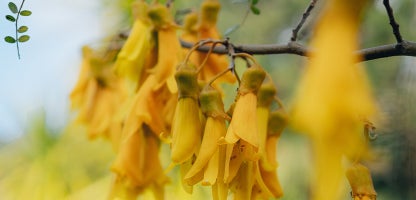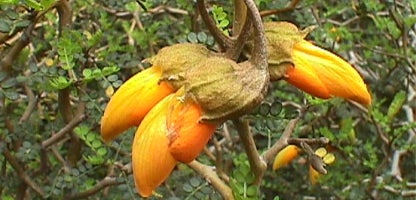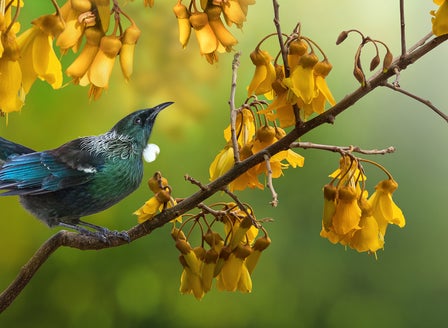New Zealand's well known Iconic yellow spring flowering native. If you would like to bring birds to your garden then plant a Kowhai. Tui and the native Kereru (Wood Pigeon) love the flowers of Kowhai. Coming in a range of species from Dwarf types to divaricating ones there is one for every garden style.
Planting Calendar
Kowhai can be planted throughout the year but do better when planted in spring and autumn, giving it time to establish their roots before the heat of summer.
Prepare
Position
Kowhai can grow in either sun or shade, but do best with protection from strong winds. Dwarf varieties are great when planted into containers.
Soil
When planted into the ground Kowhai likes a free draining soil that is rich in organic matter. To improve the organic content in your soil, break up the soil, add Kings Compost and Kings Sheep Pellets then mix together well. When growing in containers, plant into Kings Container mix. This mix contains added water storage crystals and Saturaid, two products that help maintain moisture in the soil.
Plant
When planting into the ground, gently tap the plant out of its pot. Dig a hole twice the depth and width of the plants root ball. Mix Kings Compost into your existing soil at a 50/50 ratio, add Sheep Pellets and Kings 24 Plus Fertiliser, then mix together. Back fill the hole with this soil, so that when planted the top of the plant’s roots sit level with the surrounding ground. Firm the soil down gently and water in well with Aquaticus Organic Garden Booster. In heavier clay soils, where drainage is likely to be an issue, plant onto a raised mound and sprinkle Gypsum Clay Breaker into the bottom of the hole, this helps slowly condition the soil and help to break down the clay. When growing in containers, plant into Kings Container mix. This mix contains added water storage crystals and Saturaid, two products that help maintain moisture in the soil.
Care
Watering
Watering is essential especially in the first year of planting to allow the roots to get well established. Water slowly allowing the water to sink down into the roots, rather than allowing it to run off the top of the soils surface. Add Saturaid into the soil at planting as this will help channel the water deep down into the root zone. Consider setting up an automatic watering system – these can be simple and inexpensive
Feeding
When planted in the ground liquid feed every month with Aquaticus Garden Booster, from spring through to the end of autumn, this encourages root growth and increases the microbial activity in the soil. Monthly applications of Kings Sheep Pellets will help with soil conditioning and plant health. If planted into a container, feed with Kings Liquid Fast Food along with monthly applications of Aquaticus Organic Garden Booster this encourages strong roots and a healthy immune system.
Mulching
Mulch around the base of the plants (make sure that the mulch does not come into direct contact with the stem of the plant) with Tui mulch & Feed. Mulching helps to reduce weeds as well as aiding the soil to retain moisture.
Spraying
Kowhai can be attacked by Kowhai Moth Caterpillar. At first sign of chewed leaves spray with Groventive Garden. For a Organic option spray with Bugtrol.
Pruning
The only pruning required would be to remove and dead wood or broken branches.
Beginner Tip
Kowhai are semi deciduous and often lose their leaves in winter prior to flowering.
Tip
Take care when spraying with weed killer as Kowhai are very sensitive to herbicides.
Top Varieties

Sophora tetraptera
Large Leaved Kowhai is the native icon we all recognise. Growing to 10m x 3m at maturity.

Sophora “dragons gold”
Dwarf Kowhai suited for smaller gardens and containers. Growing to 2m x 2m.

Sophora prostrata Dwarf Kowhai.
This form has a intertwining (divaricating) growth habit and is well suited to growing on dry banks and windy situations. Growing to 2m x 2m
Frequently Asked Questions
When is the best time for planting Kowhai?
The best time to plant Kowhai is in late winter to early spring (August to September). This allows the tree to establish roots before the warmer summer months.
How often should I water my Kowhai tree?
Watering is essential especially in the first year of planting to allow the roots to get well established. Water slowly allowing the water to sink down into the roots, rather than allowing it to run off the top of the soils surface. Add Saturaid into the soil at planting as this will help channel the water deep down into the root zone. Consider setting up an automatic watering system – these can be simple and inexpensive
Can I grow Kowhai in a pot?
Yes, Kowhai can be grown in a large pot, especially dwarf varieties. Ensure the pot has good drainage and use a quality potting mix. Regular watering and fertilising will be necessary to keep the tree healthy.
How long does it take for a Kowhai tree to flower?
Kowhai trees typically start to flower after 3-5 years. However, this can vary depending on growing conditions and care. Be patient, as the stunning yellow blooms are worth the wait!
Do Kowhai trees need fertiliser?
When planted in the ground liquid feed every month with Aquaticus Garden Booster, from spring through to the end of autumn, this encourages root growth and increases the microbial activity in the soil. Monthly applications of Kings Sheep Pellets will help with soil conditioning and plant health.
